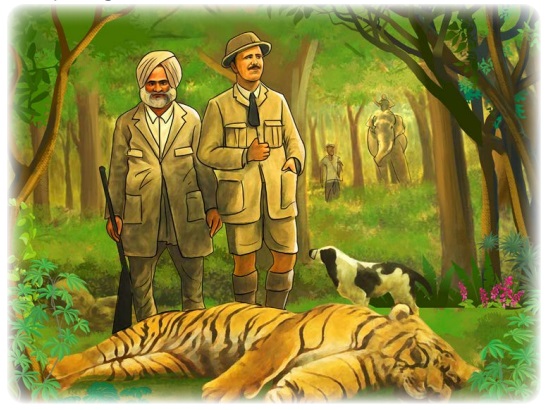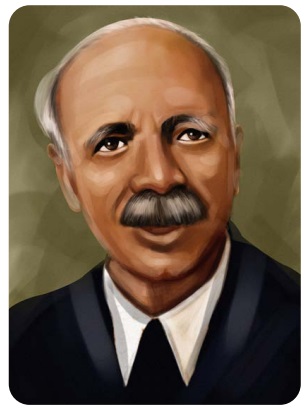Supplementary - Unit 2 - 8th English - Jim Corbett, A Hunter Turned Naturalist | 8th English : Unit 2 : Supplementary : Jim Corbett, A Hunter Turned Naturalist
Chapter: 8th English : Unit 2 : Supplementary : Jim Corbett, A Hunter Turned Naturalist
Jim Corbett, A Hunter Turned Naturalist
UNIT 2
Supplementary

Jim Corbett,
A Hunter Turned Naturalist
Edward
James Corbett, popularly known as Jim Corbett was a British wild life photographer,
hunter, tracker, naturalist, and writer. He has hunted a number of man-eating tigers
and leopards in India. He had a lot of experience with tigers and other wild animals
to shoot with his cine film camera. Corbett always preferred to hunt alone and on
foot. He often hunted with
Robin, his dog. Though he was an expert hunter, he admired wild life. He did not
like to kill wild animals for pleasure or sport. But he did not hesitate
to kill man-eating tigers or leopards.
He hunted these animals only to help people and only at the request of the Government.
He took no joy from the kill. He often said that not against the law of nature,
but against the laws of human.”

According to his theory, a tiger starts eating humans, when they
grow old or get hurt. As, they can not run fast, they start killing humans. People
can not run as fast as animals, so they become easy prey. After eating human flesh
once, a tiger will not eat any other flesh. These tigers are called man-eaters.
His first, man eating tiger hunt was, The Champawat Tiger. It was
a Bengal tigress responsible for nearly 436 deaths in Nepal and the Kumaon area
of India. Her attacks have been listed in the Guinness Book of World Records as
the highest number of fatalities from a tiger. She was shot in 1907
by Jim Corbett.
The tigress began her attacks in a Rupal village in western Nepal,
Himalayas. Hunters were sent to kill the tiger, but
she managed to escape from them. The Nepalese Army, after failing to capture or
kill the tiger, drove her across the border into India. There she continued her
killings in the Kumaon District. All her kills happened during the daylight. After
several incidents people stopped going into the forest, to collect firewood, fruits,
roots and other things. They were terrified to go out, and refused to leave their
huts for work after hearing her roar from the forest. The British government requested
Jim Corbett to help the villagers. He agreed to hunt down the man-eater.
He camped in the Kumaon District, and started tracking the tigress.
He moved around the villages and restricted the activities of the man-eater.
After several unsuccessful attempts, Corbett managed to kill, the tiger when it
killed a 16-year-old girl, in the village, near Champawat, and left a trail of blood, which Corbett followed. After
a whole day of pursuit, Corbett had to abandon the hunt, decided to use villagers
and to organise a bait the next day near the Champa River. With the help of the
thasildar of Champawat, the bait was organised with about 300 villagers. The next
day, Corbett shot the tigress dead, near the Chataar Bridge, in Champawat. A "cement
board" was erected, marking the place where the tigress was finally brought
down.
A postmortem on the tigress showed the upper and lower canine teeth
on the right side of her mouth were broken, the upper one in half, the lower one
right down to the bone. This injury was a result of an old gunshot from a game hunter
who failed to track and kill it. According to Corbett, probably this injury prevented
her from hunting her natural prey, and hence, she started to hunt humans.
DO YOU KNOW
Jadav
Payeng is better known as the Forest Man of India. He earned this name by
spending 30 years of his life planting trees, creating a real man-made forest
of 550 hectares.

Jim Corbett was always against game hunting. He strongly
advocated that deforestation and human encroachment were the main cause of the mischief
of wild animals. He went on lecturing tours to educate the people about their natural
heritage and the need to conserve forests and their wildlife. He promoted the "Association
for the Preservation of Game "and the "All-India
Conference for the Preservation of Wildlife." He played a key role in establishing,
India's first national park in the Kumaon Hills, the Hailey National Park, in Uttarakhand,
India. It was initially named after, Lord Malcolm Hailey. Jim Corbett died on 19
April 1955. The park was renamed in 1957 as, The Jim Corbett National Park. It was
named after him to honour his role in establishing this protected area in 1930s.
Related Topics